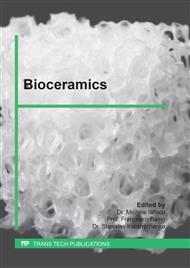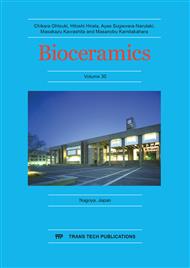[1]
S. M. Kurtz, J. N. Devine, PEEK Biomaterials in trauma, orthopedic, and spinal implants, Biomaterials. 28 (2007) 4845-4869.
DOI: 10.1016/j.biomaterials.2007.07.013
Google Scholar
[2]
J. J. Yang, C. H. Yu, B-S. Chang, J. S. Yeom, J. H. Lee, C-K. Lee, Subsidence and Nonunion after Anterior Cervical Interbody Fusion Using a Stand-Alone Polyetheretherketone (PPEK) Cage, Clin. Orthop. Surg. 3 (2011) 16-23.
DOI: 10.4055/cios.2011.3.1.16
Google Scholar
[3]
R. Ma and T. Tang, Current Strategies to Improve the Bioactivity of PEEK, Int. J. Mol. Sci. 15 (2014) 5426-5445.
DOI: 10.3390/ijms15045426
Google Scholar
[4]
S. Najeeb, Z. Khurshid, J. P. Matinlinna, F. Siddiqui, M. Z. Nassani, K. Baroudi, Nanomodified Peek Dental Implants: Bioactive Composites and Surface Modification-A Review, Int. J. Dent. (2015) 1-7.
DOI: 10.1155/2015/381759
Google Scholar
[5]
P. Johansson, R. Jimbo, P. Kjellin, F. Currie, B. R. Chrcanovic, A. Wennerberg, Biomechanical evaluation and surface characterization of a nano-modified surface on PEEK implants: a study in the rabbit tibia, Int. J. Nanomedicine. 9 (2014).
DOI: 10.2147/ijn.s60387
Google Scholar
[6]
K. F. Tamrin,Y. Nukman, S. S. Zakariyah, Laser lap joining of dissimilar materials: a review of factors affecting joint strength, J. Mater. Manufac. Proc. 28 (2013) 857-871.
DOI: 10.1080/10426914.2013.792413
Google Scholar
[7]
Y. Kawahito, K. Nishimoto, S. Katayama, LAMP Joining between Ceramic and Plastic, Phys. Procedia. 12 (2011) 174-178.
DOI: 10.1016/j.phpro.2011.03.022
Google Scholar
[8]
Z.S. Tao, B.L. Bai, X.W. He, W. Liu, H. Li, Q. Zhou, T. Sun, Z.L. Huang, K.K. Tu, Y.X. Lv, W. Cui , L.Yang, A comparative study of strontium-substituted hydroxyapatite coating on implant's osseointegration for osteopenic rats, Med. Biol. Eng. Comput. 54(12) (2016 ) 959-(1968).
DOI: 10.1007/s11517-016-1494-9
Google Scholar
[9]
A.E. Porter, T. Buck and, K. Hing, S.M. Best, W.Bonfield, The structure of the bond between bone and porous silicon-substituted hydroxyapatite bioceramic implants, J Biomed Mater Res A. 78(1) (2006) 25-33.
DOI: 10.1002/jbm.a.30690
Google Scholar
[10]
M. Akahane, Y. Tanaka and A. Furukawa, Japan Patent Application, JP2018-76223A(2018).
Google Scholar



